A Summer of Science
Summer Poster Days Showcase IRP Summer Intern Research
Every summer, NIH welcomes hundreds of enthusiastic young men and women to its campuses to work as summer interns, providing them with scientific training and mentorship from some of the world’s preeminent researchers. As always, the Summer Internship Program culminated this year with Summer Poster Days, held on August 1 and 2, a bustling event where summer interns showcase the results of their immersion into IRP research. Nearly 800 IRP summer interns participated in this year’s event, presenting research on cancer vaccines, new applications for virtual reality technology, experimental antifungal treatments, how the brain perceives pitch in sounds, and much more. Read on for a glimpse at some of this year’s summer interns and the work they braved a blazing Washington, D.C., summer to pursue.
Amarachukwu Uzondu: A Vocal Venture to Assess Frailty
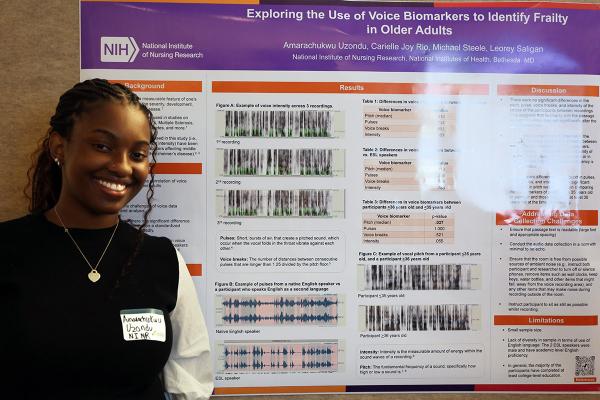
As interested as Amara has long been in science, her path to research was fueled primarily by an interest in social justice. That interest led her to join a lab at Hampton University, a historically Black university where she is currently a rising senior majoring in nursing and helping researchers develop strategies for improving the safety and mental health of black women in the surrounding community.
“A faculty member mentioned research to me and some other students, and I realized that I could fulfill my passion for social justice through research that could impact healthcare policy and improve outcomes for underserved populations,” Amara says.
When it came time to choose a group to work with at NIH, IRP senior investigator Leorey Saligan, Ph.D., R.N., seemed to be a perfect fit, seeing as he is both a nurse and a graduate of Hampton University.
“Not a lot of senior researchers at NIH have degrees from historically Black colleges and universities, much less the one that I attend, so I figured why not reach out,” she recalls. “Our paths have been very similar, and I knew that the shared college experience would make for a great working environment and a space where I could grow as a researcher.”
Under the guidance of Dr. Saligan and his IRP team, Amara has been exploring how to use the characteristics of a person’s voice to assess frailty in older adults. While older individuals in poor physical shape might be colloquially described as ‘frail,’ it is also a clinical diagnosis with specific symptoms, and it is known that clinically frail individuals are at greater risk of disability, hospitalization, and death. If they can figure out a way to detect frailty using someone’s voice, researchers like Amara and her IRP colleagues could help healthcare providers identify the condition sooner, as well as help people with less access to healthcare get a diagnosis and appropriate support.
“It was definitely a new topic for me, but as I reviewed the scientific literature, conducted data collection, and drafted standard operating procedures for this project, I began to see the amazing impact voice analysis could have in healthcare and in lessening the healthcare disparity gap amongst underserved populations,” Amara says.
While her pilot study in Dr. Saligan’s lab included only 12 individuals, it did suggest that aspects of someone’s voice that are used to identify frailty may not be affected by a person’s familiarity with the standardized passage they need to read for the assessment or whether the patient is a native English speaker. If larger studies corroborate those findings, it will make it easier to find a way to use that approach to diagnose frailty and, perhaps, other conditions as well.
Amara describes her summer at NIH as “nothing short of amazing.” She feels “empowered” by the chance to experience what it might be like to have a career in research, as well as the opportunity for a sneak peak behind the curtain of life as a nurse.
“I was able to shadow and meet with many nurses and nurse practitioners at NIH who gave me advice on my future endeavors as a nursing student,” she says. “They allowed me to see the various roles that nurses and nurse practitioners take on at NIH, and that everyone’s path does not look the same. Overall, I am extremely grateful for this experience and the many opportunities my summer at NIH has afforded me.”
Fun fact: During the 2024-2025 academic year, Amara will serve as the 67th Miss Hampton University.
Joseph Lang: Radiation Research to Support Space Voyages
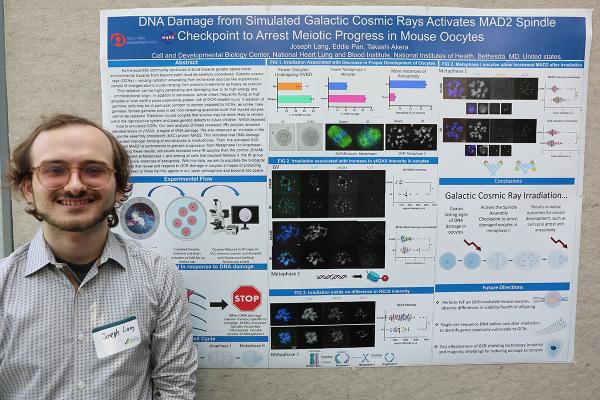
Many scientists dabble in several topics before ultimately finding the one they want to spend their life studying, but Joseph has long been focused on one specific goal.
“My primary career aspirations involve contributing to the forefront of the fertility field to aid all families on their fertility journey,” he says. “I plan to advance compassionate, personalized care for those seeking fertility treatment so that certain obstacles no longer impede the growth of loving families. I view my work with mouse models this summer as the latest in a long series of stepping stones toward that ultimate goal.”
While studying biological sciences at Cornell University in New York, where he is a rising senior set to graduate early this fall, Joseph worked at the University’s Baker Institute of Animal Health. His research there focused on the factors that influence how sperm take in calcium, which plays a vital role in their ability to fertilize an egg. Consequently, when it came time to choose an IRP lab to work in this summer, Joseph was interested in studying the female side of fertility. This led him to IRP Stadtman Investigator Takashi Akera, Ph.D., whose research team studies factors that affect the DNA of egg cells and thereby influence women’s fertility and the health of their children.
Joseph’s specific project this summer focused on investigating how the radioactive ‘cosmic rays’ that astronauts are exposed to while outside Earth’s protective atmosphere might affect their reproductive cells. Dr. Akera’s team had obtained ovaries from mice that NASA exposed to simulated cosmic rays produced by a particle accelerator, and Joseph helped his lab discover that egg cells from those ovaries had damaged DNA and often developed abnormally. What’s more, he assisted with experiments that identified a process that stops egg cells with damaged DNA from progressing to the fertile stage, although that process didn’t always work.
“Cellular damage is often more difficult to detect in egg cells than in external or quickly renewing cells,” Joseph says. “Radiation-injured eggs also cannot be replaced, so damaged eggs that survive may eventually lead to genetic defects in offspring or infertility. Establishing procedures by which we can detect damage to egg cells from space radiation and understand how these vulnerable cells respond will enable efficient testing of the effectiveness of any radiation shielding technology NASA develops before sending astronauts deeper into space, while also underscoring the importance of this protection.”
During his summer at NIH, Joseph was heartened by the faith his colleagues in the Akera lab placed in him to play an important role in their experiments. As a result, he has emerged from the experience more certain than ever that he has what it takes to succeed as a fertility researcher in the future.
“They trusted me with an important project, enabling me to succeed through merit while also providing all of the guidance I needed,” Joseph says. “I feel I was incredibly lucky to arrive at a lab full of such kind and competent people, and I know that this experience will serve as a source of confidence and drive in future endeavors.”
Fun fact: In addition to being a science nerd, Joseph is also a theater nerd. He has acted in or directed seven different Shakesperean plays, as well as many other productions.
Johnathan Mo: Expanding the Capabilities of Augmented Reality
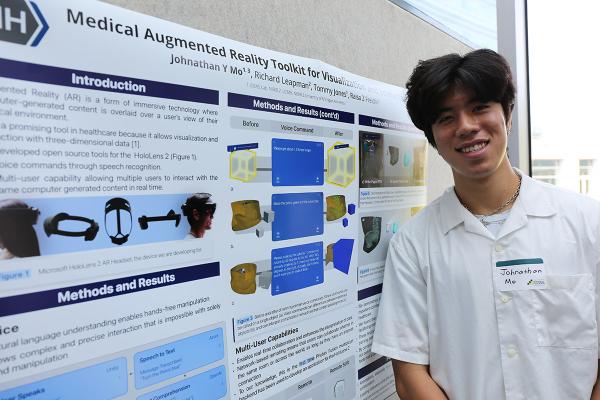
Johnathan traces his passion for science back to joining his middle school’s science bowl team, which required him to spend time outside of school learning long lists of facts about the natural world.
“Through studying biology, physics, and chemistry on my own time, I found that I enjoyed gaining a better understanding of how the world works,” he says. “Then, in high school, I became fascinated with the realm of medicine — applying science to help others.”
Many turn that kind of fascination into a career as a doctor, but Johnathan’s love of computers spurred him to take another path. So far, he has tried his hand at applying artificial intelligence to diagnosing skin ailments in people from diverse racial and ethnic backgrounds and at using computer applications to combine two-dimensional images of mouse brains into three-dimensional images. This summer, he joined NIH's Instrumentation Development and Engineering Application Solutions (IDEAS) lab, where he worked closely with computer engineer Raisa Freidlin, Ph.D., and other IDEAS lab engineers to create an ‘augmented reality’ (AR) application designed to help doctors visualize and interact with medical information.
“I’m very interested in engineering solutions to healthcare problems, and the IDEAS lab was the perfect place for me to do a computer science project that had a biomedical application,” Johnathan explains.
In just a few months, Johnathan and his colleagues managed to add voice commands to their AR system that allow doctors to influence what they see with simple verbal instructions. The team also added the capability for multiple users to see and interact with the same information simultaneously using the lab’s augmented reality platform, allowing doctors to collaborate in real time from anywhere in the world.
“This research is incredibly important because it has the potential to provide doctors and surgeons with new ways of visualizing data that can improve surgical outcomes,” Johnathan says. “Furthermore, these tools also hold applications in medical education and remote telemedicine.”
This video shows a demonstration of the augmented reality platform Johnathan worked on over the summer.
Despite spending much of his time at NIH interacting with computers and software, the best parts of Johnathan’s summer came from his interactions with flesh-and-blood human beings.
“My favorite part has undoubtedly been the process of meeting and getting to know the other interns in my lab and my program — being able to learn about other student’s work and bond over our shared experiences,” he says.
Fun fact: In his free time, Johnathan enjoys photography and video editing.
Isabel Carino-Bazan: Evaluating Exercise’s Effects on the Brain
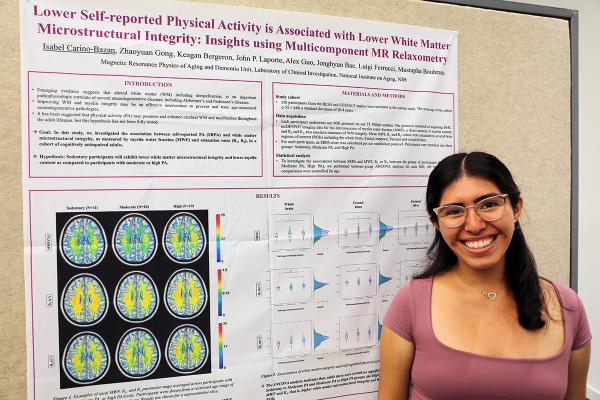
Unlike many of her fellow IRP summer interns, Isabel’s interest in science is only a few years old. In her senior year of high school, she found herself intrigued by her lessons on evolution and behavior. More recently, some personal revelations from close friends spurred her to seek out an internship with IRP Stadtman Investigator Mustapha Bouhrara, Ph.D., so she could help scientists learn more about the aging brain.
“I became interested in my research from this summer when I learned that many of my friends have a family history of Alzheimer’s disease and Parkinson’s,” Isabel says. “The way Dr. Bouhrara group goes about this research is really interesting to me.”
That’s because Dr. Bouhrara’s lab learns about those sorts of conditions, which are more common in older individuals, using neuroimaging technology that allows researchers to visualize the brain’s structure and composition in great detail. Isabel spent her summer specifically working with brain scans that revealed the amount of a protein called myelin in the brain, which wraps around the parts of neurons that transmit electrical signals across the brain. Because myelin is relatively light in appearance compared to the rest of the brain, those myelin-wrapped nerve fibers are referred to as ‘white matter.’
In diseases like Alzheimer’s and Parkinson’s, the brain’s white matter breaks down. However, Isabel’s research this summer suggests that sort of structural degradation in the brain might be staved off longer in people who get regular physical activity, as she found that brain scans from people who reported higher levels of physical activity showed more structurally sound white matter and higher amounts of myelin.
“This work is important because two of our imaging metrics could be used as imaging biomarkers to predict white matter changes,” Isabel explains. “These two could be used in longitudinal assessment and as interventional targets for age-related or neurodegenerative processes.”
While her summer at NIH was not Isabel’s first foray into research, working with neuroimaging data was a significant departure from her previous experiences in college studying the behavior of cavefish and the DNA of mice. Consequently, her internship had a significant learning curve, but that just contributed to the sense of accomplishment she now feels about the experience.
“Being a summer intern has been challenging but also very rewarding,” she says. “Challenging because I had no prior experience with this specific topic, but very rewarding because of the many skills I learned along the way.”
Fun fact: In addition to a major in molecular biology, Isabel is working towards a degree in economics. She is also a music lover, and her experiences as a musician have been as eclectic as her educational pursuits, since she plays five different instruments.
Thomas Savage: Scrutinizing Salivary Gland Disease
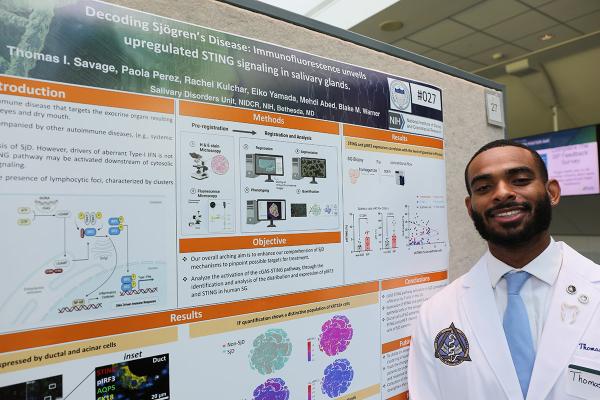
Medical school provides students a chance to sample a variety of fields before they settle on one to dedicate their career to, but Thomas didn't need that kind of experimentation to know what area of medicine he wanted to specialize in, opting to enroll in dental school at Howard University in Washington, D.C. Naturally, when he decided to spend a summer conducting research at NIH, he sought out a lab that aligned with his interest in oral health, which is how he ended up working with IRP Stadtman Investigator Blake Warner, D.D.S., Ph.D., himself a dentist.
Together, the two have been exploring the origins of an autoimmune disease known as Sjögren’s Disease, in which the immune system attacks moisture-producing glands like the eyes’ tear ducts and the saliva glands. The resulting dry eyes and mouth can be extremely uncomfortable and make eating difficult.
“Learning just the brief name and a few PowerPoint slides about Sjögren’s in dental school wasn’t enough for me, but being a part of a lab researching the mechanisms behind this disease and trying to figure out a possible treatment for it intrigued my interest,” Thomas says. “Given that Sjögren’s is a common disease I will likely encounter in my future practice as a dentist, gaining insight into its mechanisms and potential therapies is invaluable. Working in this lab allowed me to contribute to meaningful research that bridges the gap between the scientific side of oral health and clinical application, aligning perfectly with my career goals.”
During his summer in Dr. Warner’s lab, Thomas analyzed images of salivary gland samples from people with and without Sjögren’s to determine how active a particular biological pathway, known as the cGAS-STING pathway, is in the glands. His experiments not only showed that the pathway was more active in the patients’ salivary glands, but that higher activity in the pathway was associated with the presence of more immune cells in the gland, suggesting a link between the cGAS-STING pathway and the unrestrained immune system assault responsible for the condition’s symptoms.
“Research on this particular topic is essential because it helps us enhance our comprehension of the disease’s mechanisms to possibly pinpoint targets for treatment,” Thomas explains.
Thomas describes his summer at NIH as “one for the books,” specifically citing the opportunity to work closely with many “influential minds” as his favorite part of the experience. That close collaboration with colleagues enabled Thomas to overcome the many challenges his internship threw at him and grow immensely from the experience.
“I felt as if every day in the lab I was challenged with a problem with the software or even with my first time being in a lab conducting research,” Thomas says. “The fun part was finding ways to overcome and learning more about myself in the process. Every day I learned something new, and I know that I’m leaving here this summer as a better student, future clinician, and even friend.”
Fun fact: Thomas has an extra tooth in his upper jaw, which he says, “hinted to me early in my life that I would one day become a dentist.”
Subscribe to our weekly newsletter to stay up-to-date on the latest breakthroughs in the NIH Intramural Research Program.
Related Blog Posts
This page was last updated on Monday, August 19, 2024
